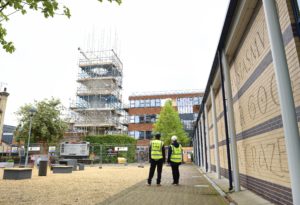Work has begun on the construction of a new health and wellbeing quarter at the University of Suffolk in Ipswich.
The space will include the Integrated Care Academy (ICA); a unique alliance between the University, NHS Integrated Care System and Suffolk County Council. It will be an area of the campus dedicated to the promotion of integrated care amongst the student body, practice partners and the wider community.
The project is supported by £4m from New Anglia LEP’s Getting Building Fund. New Anglia LEP has been awarded £32.1m as part of the Government’s Getting Building Fund, which will plough £900m into projects across the country to help deliver jobs, skills and infrastructure in the wake of the Covid-19 pandemic
The building at the University of Suffolk will house brand-new clinical simulation facilities, two state of-the-art hospital wards, a midwifery birthing unit, a new sports and exercise facility, a working radiography imaging suite and counselling/physiotherapy clinic rooms. The facilities will mirror those you would expect to see in hospitals, clinics, laboratories, as well as other professional healthcare centres. It is due to be complete in early 2022.
To support the changing needs of health and social care services the new building will enable the University to double the number of places for students wishing to study as nurses, midwives, paramedics and radiographers as well as starting a new course in physiotherapy. It will give local people an increased opportunity to be part of the local health and care workforce and will become a centre of excellence which will attract new students from across the globe, impacting positively on the wider economy.
Dr Paul Driscoll-Evans, Dean of School Health and Sports Sciences, said “These new facilities will allow the University of Suffolk to shape the future of our health and social care services.
“By providing the profession with graduates who embrace the value of integrated care, who have experience of working within environments that simulate clinical practice, and who have an understanding of the new technologies and equipment that is in situ in hospitals and medical facilities.
“Our students will also have access to academic staff and clinicians who promote research-based practice. I’m proud to be part of this initiative and I am looking forward to seeing our students use the facility in 2022.”





